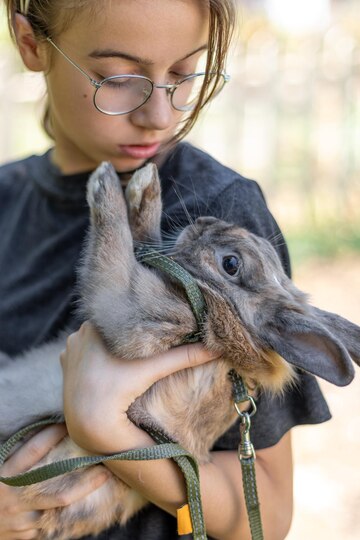Rabbits are some of the most beloved pets around the world, known for their fluffy tails, twitching noses, and playful personalities. Whether you’re considering adopting a rabbit or simply want to learn more about these fascinating animals, this blog post will cover everything you need to know about rabbits, from their biology and behavior to care tips and cultural significance.
The Biology of Rabbits
Rabbits are members of the family Leporidae and are classified as lagomorphs, which also includes hares and pikas. The European rabbit (Oryctolagus cuniculus) is the most common domestic breed, with various species and breeds showcasing different sizes, colors, and temperaments.
Physical Characteristics
Rabbits have distinctive features that make them easily recognizable. Their long ears can detect a wide range of sounds, and their powerful hind legs allow them to jump great distances—an essential skill for escaping predators. Most rabbits have a compact body covered in soft fur, making them incredibly appealing as pets.
Diet and Digestion
As herbivores, rabbits have a specialized diet that primarily consists of hay, fresh vegetables, and pellets. Their digestive systems are unique; they rely on high-fiber foods to keep their gut healthy. An interesting fact is that rabbits practice coprophagy, meaning they eat their own droppings to absorb essential nutrients more effectively.
Diet and Digestion of Rabbits
Rabbits have unique dietary needs that are crucial for their health and well-being. Understanding their diet and digestion will help you provide the best care for your furry friend.
Diet Basics
Rabbits are strict herbivores, which means they primarily eat plant-based foods. Their diet should consist of the following components:
- Hay: The cornerstone of a rabbit’s diet should be high-quality hay, such as timothy hay, meadow hay, or orchard grass. Hay is essential for providing the necessary fiber that promotes healthy digestion and keeps their teeth worn down.
- Fresh Vegetables: Leafy greens are an excellent addition to a rabbit’s diet. Offer a variety of vegetables daily, including romaine lettuce, kale, cilantro, and parsley. Avoid starchy vegetables like potatoes and corn, which should be fed in moderation.
- Pellets: Commercial rabbit pellets can be provided in limited amounts. Choose high-fiber pellets with no added seeds or dried fruit. Pellets should complement, not replace, hay and fresh vegetables in their diet.
- Fresh Water: Always ensure your rabbit has access to clean, fresh water. Water bottles or bowls work well, but make sure they are easily accessible.
Social Behavior
Rabbits are inherently social animals that thrive in groups. In the wild, they form colonies, which helps them stay safe from predators.
Social Behavior of Rabbits
Rabbits are inherently social creatures with complex behaviors that play a significant role in their well-being. Understanding their social nature is essential for providing the right environment and companionship for your pet. Here’s a closer look at rabbit social behavior.
The Importance of Social Interaction
- Pack Animals: In the wild, rabbits live in large colonies or groups. This social structure helps them avoid predators and provides support in caring for young. As domesticated pets, rabbits still retain these instincts and thrive on companionship.
- Bonding with Humans: Many rabbits form strong bonds with their human caretakers. Regular interaction, gentle handling, and playtime can strengthen this bond. Socialization from a young age helps rabbits become more comfortable with people and their environment.
- Companionship with Other Rabbits: If possible, keeping rabbits in pairs or groups can greatly enhance their happiness. They engage in social grooming, play, and cuddling, which are all important for their emotional health. When introducing new rabbits, gradual introductions are crucial to establish a harmonious relationship.
Communication Styles
Rabbits communicate in various ways, including body language and vocalizations. They might thump their hind legs to warn of danger or nuzzle to show affection. Understanding these signals can greatly enhance the bond between you and your pet rabbit.
Cultural Significance
Rabbits have held a prominent place in folklore and culture for centuries. They are often symbols of fertility and renewal, making them significant during spring celebrations like Easter.
Rabbits in Literature and Media
From the Easter Bunny to characters like Bugs Bunny and Peter Rabbit, rabbits have become iconic figures in literature and media. These characters often embody cleverness and mischief, highlighting the playful nature of rabbits.
Caring for Your Rabbit
If you’re thinking about bringing a rabbit into your home, it’s essential to understand their needs to provide a happy and healthy life.
Creating a Safe Environment
Rabbits need a spacious and secure habitat. A large enclosure that allows them to hop and explore is crucial. It’s also important to create hiding spots where they can retreat to feel safe.
Nutrition Basics
A well-balanced diet is vital for a rabbit’s health. Fresh hay should be the main component of their diet, along with a variety of leafy greens and a limited amount of pellets. Always ensure they have access to clean, fresh water.
Social Interaction and Exercise
Rabbits thrive on social interaction, whether with other rabbits or humans. They require daily playtime outside their enclosure for exercise and mental stimulation. Engage in gentle play and provide toys to keep them entertained.
Regular Veterinary Care
Routine veterinary check-ups are important to monitor your rabbit’s health. Spaying or neutering is recommended to prevent behavioral issues and health risks.
Conclusion
Rabbits are enchanting creatures that can bring joy and companionship into your life. By understanding their biology, behavior, and care needs, you can create a loving environment for your furry friend. Whether you’re already a rabbit owner or considering adopting one, embracing the unique qualities of rabbits will enrich your experience. Welcome to the wonderful world of rabbits!
